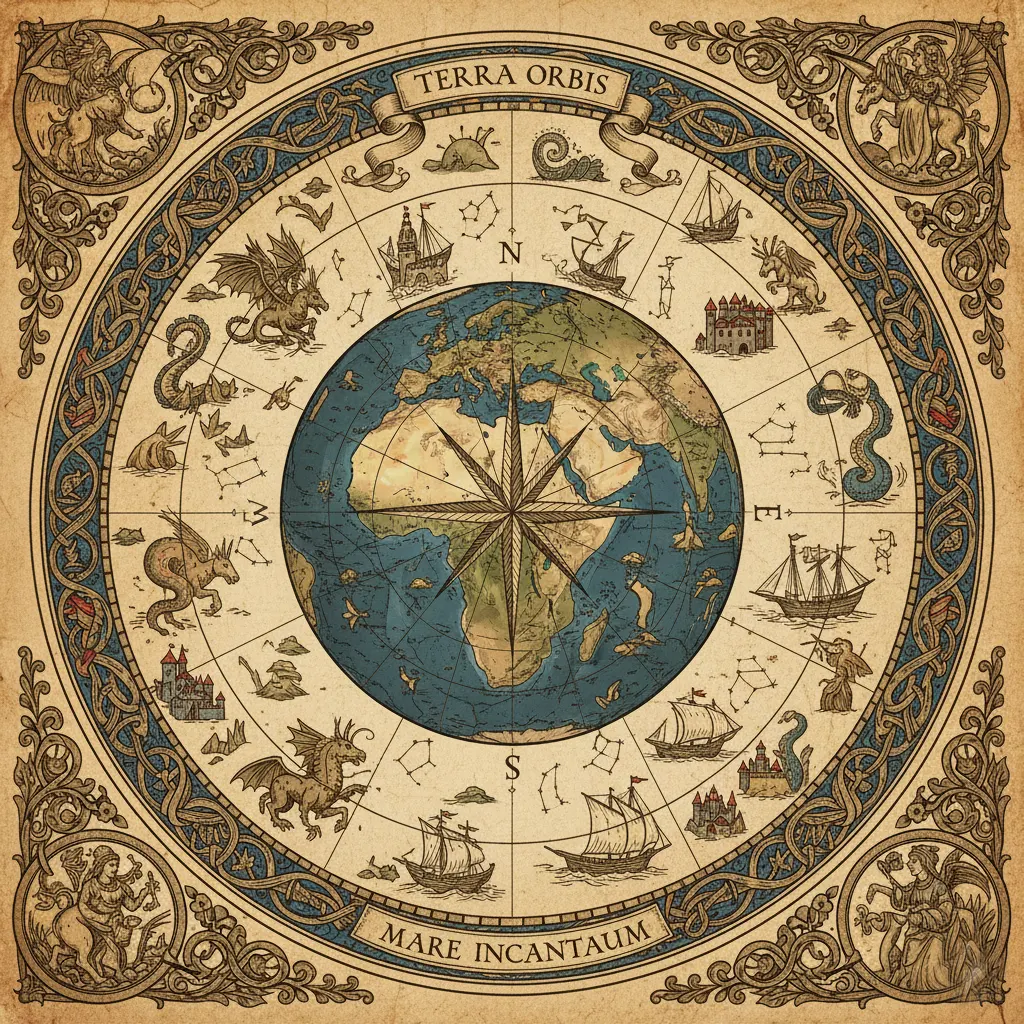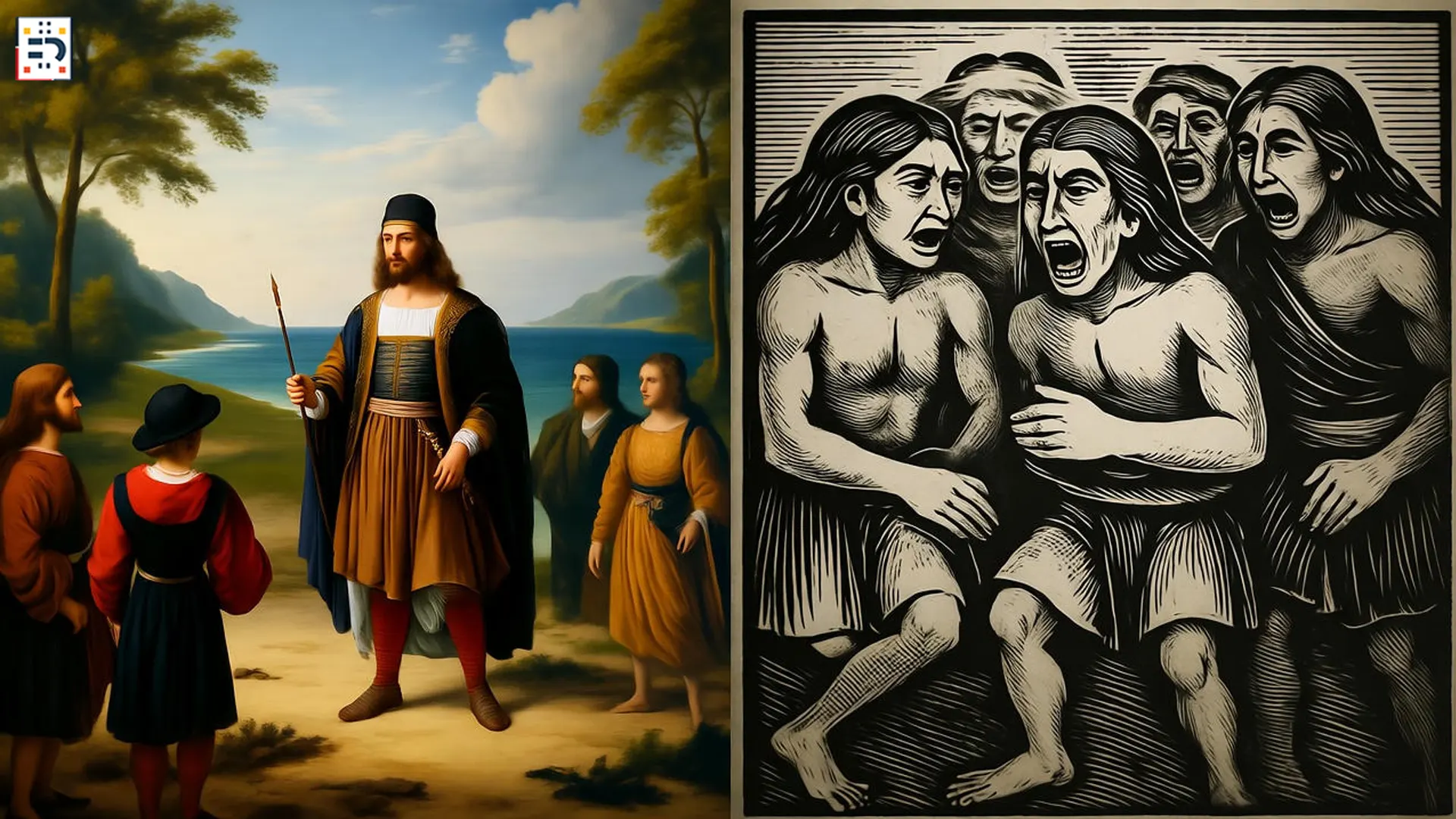Think of Christopher Columbus. You likely see a visionary explorer. He bravely steers his ships into the unknown. He defies superstitious sailors fearful of a flat Earth. Ultimately, he “discovers” a new world. We learn this story as children. It feels simple and heroic.
However, this narrative is almost entirely false.
The Columbus we know is a character, not a real person. He is a creation myth for the Americas. This myth was crafted over centuries. The true story is far more complex and dark. It is also more significant for understanding our world today. This is a tale of collision, not discovery. It is a story of brutal ambition, not pure heroism. Let’s pull back the curtain on the five most persistent myths.
Myth #1: “Columbus Proved the Earth Was Round”

The Schoolbook Story: Columbus was a revolutionary thinker. He battled primitive flat-Earth dogma. He courageously set sail while others cowered in fear.
The Historical Reality: Educated Europeans knew the Earth was spherical for over 1,600 years. The ancient Greek philosopher Eratosthenes demonstrated this in the 3rd century BCE. He even calculated its circumference with amazing accuracy. Medieval Islamic scholars and European universities all accepted a round Earth.
So, what was the real debate? Size. Columbus used flawed calculations. He insisted the Earth was much smaller than it is. His critics knew the distance to Asia was impossibly far. They were correct. In fact, only the unforeseen Americas saved Columbus and his crew from vanishing at sea.
Myth #2: “Columbus Discovered America”

The Schoolbook Story: Columbus was the first to arrive. He found a “New World” that was empty and waiting.
The Historical Reality: This myth erases millions of people. To say Columbus “discovered” America is like saying a man “discovers” a bustling city by walking into it.
- The First Peoples: Humans lived in the Americas for at least 15,000 years. The hemisphere was full of diverse, complex civilizations.
- The Norse Voyages: Leif Erikson built a settlement at L’Anse aux Meadows in Newfoundland around 1000 AD. This was nearly 500 years before Columbus.
- Other Contacts: Evidence also suggests potential Polynesian voyages to South America.
Therefore, Columbus did not “discover” America. Instead, he started permanent sustained contact between two worlds. This event, the “Columbian Exchange,” changed the globe forever.
Myth #3: “He Was a Visionary Hero Funded by a Bold Queen”
The Schoolbook Story: A persistent genius, Columbus convinced Queen Isabella to pawn her jewels. This funded his daring quest.
The Historical Reality: The story of the pawned jewels is a romantic lie. The expedition used money from the Spanish treasury. Furthermore, royal commissions in Portugal and Spain rejected Columbus’s proposal multiple times. Experts knew his math was wrong. As records from the Spanish court show, the King and Queen finally agreed as a low-risk gamble. The potential reward—a direct spice route—outweighed the cost. This was a business venture, not a noble scientific mission.

Myth #4: “He Was a Benevolent Friend to the Native People”
The Schoolbook Story: Columbus formed peaceful relationships with the Taino people. He traded trinkets and brought them civilization.
The Historical Reality: The truth is a harrowing account of brutality. Columbus’s own journal and witnesses like friar Bartolomé de las Casas are damning. Just days after landing, Columbus wrote that the Taino would make “fine servants.” He claimed, “With fifty men we could subjugate them all.” He immediately acted on this.
- The Enslavement System: He started the encomienda system, a form of slavery. Taino people were forced to mine gold and work plantations. The University of Oklahoma’s legal history collections detail the brutal laws used to control them.
- Violence and Disease: The Spanish systematically raped women and enacted brutal punishments. Consequently, the Taino population collapsed from several hundred thousand to just tens of thousands within two decades.
Myth #5: “His Legacy is One of Pure Celebration”
(Image Suggestion)
A modern-day photo of an Indigenous Peoples’ Day protest.
Why it works: It connects 15th-century history to today’s live debates.
The Schoolbook Story: Columbus Day celebrates Italian-American heritage and the spirit of exploration.
The Historical Reality: This celebration has always been painful for Native Americans. The holiday became popular in the 19th century. Italian immigrants used it to claim a place in American history. Unfortunately, this sanitized a horrific past for Indigenous peoples.
For them, Columbus symbolizes the start of subjugation and genocide. As a result, the movement to replace Columbus Day with Indigenous Peoples’ Day is growing. This change does not erase history. Instead, it corrects the public memory. It honors the resilience of the people who were here first. You can learn more from the National Museum of the American Indian.
Why Re-examining Columbus Matters More Than Ever
Unlearning the Columbus myth is crucial. It helps us understand the painful foundations of our modern world. The “Columbian Exchange” reshaped the globe. It transferred plants, animals, and diseases across continents.
By clinging to a fairy tale, we silence millions of Indigenous people. We also ignore patterns of conquest that still echo today. The real voyage of discovery isn’t across an ocean. It is into the pages of our unvarnished past. This journey requires courage. But in these complex truths, we find a deeper, more honest understanding of ourselves.
What part of the Columbus myth was most shocking to you? Share your thoughts in the comments below!
Want to dive deeper? We recommend exploring the works of historians like Charles C. Mann or the digital collections of the Library of Congress.
#ChristopherColumbus #ColumbusMyths #TrueHistory #IndigenousPeoplesDay #HistoryDebunked #Taino #AmericanHistory


